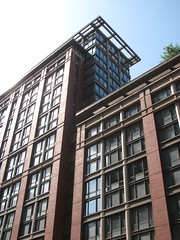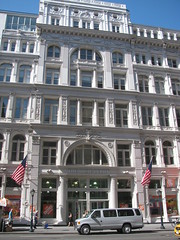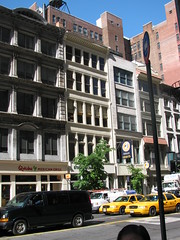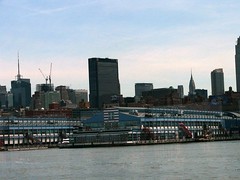South:
The Caroline

60 (corner): Commercial/ residential building completed 2002.
On the site of the Edwin Booth Theater
(1869-1883), run by and featuring New York's
most prominent Shakespearean actor—brother
of John Wilkes Booth. Sarah Bernhardt made her New York
debut here in 1880. In the basement was
Ivan Siscovitch's saloon, said to be
the "headquarters for all the noted forgers
in America." Later James W. McCreery
(1895-1907), "Dean of the Retail Trade." Demolished
1975; see an
image of the old building
here.
60 was also the address (1881-1910) of Best & Co., a children's clothing
store known as "The Lilliputian Bazaar"; it was slightly east
of the corner.
58: Site of Bonwit & Teller's second store (1898-1911); fine women's clothing.
54: This was the second location of
Schrafft's,
and the first to try out its successful formula
as a woman-oriented tea room.
52: Once the address of the American Water-Color Society.
50: Reminiscence, nostalgia kitsch;
Straight From the Crate was
Woodwind & Brasswind.
From 1898-1913, this was LeBoutillier Bros.;
from 1854-83, the site
of Calvary Baptist Church, now on
57th Street.
Stern Brothers

38-46: This was Stern Brothers Department Store,
a company founded in 1867 by Isaac, Louis and Bernard
Stern. It moved from 22nd to 23rd Street in 1978, and
this massive cast-iron expansion was built in 1892. It
was New York City's largest store until Siegel-Cooper
opened up in 1896. The store had top-hatted doormen,
but took pride in offering
goods priced for all classes. Stern's closed its
flagship store in 1970, but "SB" can still be seen
above the archway;
the facade is well-preserved, save for a defacing
modernization in the upper left corner.
Now Manhattan's first Home Depot.
32-36: The building with the large
pillars in front was apparently the original part of
Stern's, built in 1878 to a Henry Fernbach design.
Later toymaker Hasbro HQ, and also used for the toy company's
exterior in Tom Hanks' Big.
26: Jennifer Leather, sofas
24: Medici shoes
22: Mangia cafe is at the address of the Quill Club,
a club formed in 1890 for "the promotion of fellowship and
interchange of views on questions in the domains
of religion, morals, philosophy and sociology."

20: Patisserie Chanson, French bakery; used to be Shoegasm on 23rd Street, and the Murphy
Bed Center, fold-down beds for
all your screwball comedy needs.
Downstairs is Thyme, stylish cocktail bar.
The top three stories of this building illustrate
what the whole block used to look like.
18: Carrot Express, health cafe
16: Lenwich, sandwich chain
Edith Wharton birthplace

14: The
novelist
was born here January 24, 1862, in what was then an Anglo-Italianate
brownstone; has been redesigned at least three times since,
once by
Henry Hardenbergh. Recently Scott's Fifth Avenue Florist,
noted for its giant stuffed bears; now
a corporate coffee outlet.
12: This building, housing AnnSam@Chelsea, was the home of
Benjamin Nathan, former vice president of
the New York Stock Exchange, president
of the synagogue Shearith Israel, and
uncle of former Supreme Court Justice
Benjamin Nathan Cardozo. Nathan's
murder here on the night of July 28, 1870
is an enduring New York mystery.
Western Union Building

Corner (186 5th Ave): Built 1883 in Queen Anne style
(Henry Hardenbergh, arch.). Sent messages via
pneumatic tube
two and a half miles to the downtown office.
Note "W.U. 1883" near peak. Houses Luz's Shoe Repair,
J'adore French bakery.
| 
